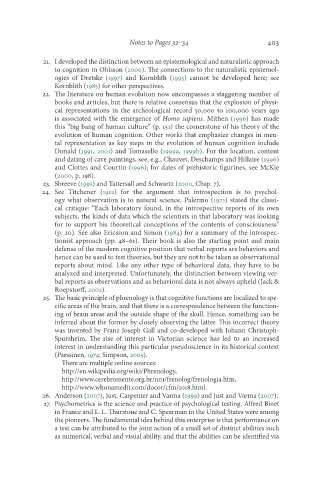Page 420 - Deep Learning
P. 420
Notes to Pages 32–34 403
21. I developed the distinction between an epistemological and naturalistic approach
to cognition in Ohlsson (2000). The connections to the naturalistic epistemol-
ogies of Dretske (1997) and Kornblith (1995) cannot be developed here; see
Kornblith (1985) for other perspectives.
22. The literature on human evolution now encompasses a staggering number of
books and articles, but there is relative consensus that the explosion of physi-
cal representations in the archeological record 50,000 to 100,000 years ago
is associated with the emergence of Homo sapiens. Mithen (1996) has made
this “big bang of human culture” (p. 151) the cornerstone of his theory of the
evolution of human cognition. Other works that emphasize changes in men-
tal representation as key steps in the evolution of human cognition include
Donald (1991, 2001) and Tomasello (1999a, 1999b). For the location, content
and dating of cave paintings, see, e.g., Chauvet, Deschamps and Hillaire (1996)
and Clottes and Courtin (1996); for dates of prehistoric figurines, see McKie
(2000, p. 198).
23. Shreeve (1995) and Tattersall and Schwartz (2000, Chap. 7).
24. See Titchener (1912) for the argument that introspection is to psychol-
ogy what observation is to natural science. Palermo (1971) stated the classi-
cal critique: “Each laboratory found, in the introspective reports of its own
subjects, the kinds of data which the scientists in that laboratory was looking
for to support his theoretical conceptions of the contents of consciousness”
(p. 20). See also Ericsson and Simon (1984) for a summary of the introspec-
tionist approach (pp. 48–61). Their book is also the starting point and main
defense of the modern cognitive position that verbal reports are behaviors and
hence can be used to test theories, but they are not to be taken as observational
reports about mind. Like any other type of behavioral data, they have to be
analyzed and interpreted. Unfortunately, the distinction between viewing ver-
bal reports as observations and as behavioral data is not always upheld (Jack &
Roepstorff, 2002).
25. The basic principle of phrenology is that cognitive functions are localized to spe-
cific areas of the brain, and that there is a correspondence between the function-
ing of brain areas and the outside shape of the skull. Hence, something can be
inferred about the former by closely observing the latter. This incorrect theory
was invented by Franz Joseph Gall and co-developed with Johann Christoph-
Spurzheim. The rise of interest in Victorian science has led to an increased
interest in understanding this particular pseudoscience in its historical context
(Parssinen, 1974; Simpson, 2005).
There are multiple online sources:
http://en.wikipedia.org/wiki/Phrenology,
http://www.cerebromente.org.br/n01/frenolog/frenologia.htm,
http://www.whonamedit.com/docor/cfm/1018.html.
26. Anderson (2007), Just, Carpenter and Varma (1999) and Just and Varma (2007).
27. Psychometrics is the science and practice of psychological testing. Alfred Binet
in France and L. L. Thurstone and C. Spearman in the United States were among
the pioneers. The fundamental idea behind this enterprise is that performance on
a test can be attributed to the joint action of a small set of distinct abilities such
as numerical, verbal and visual ability, and that the abilities can be identified via

